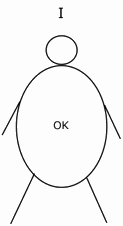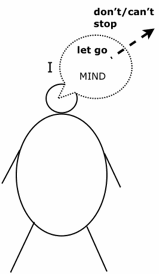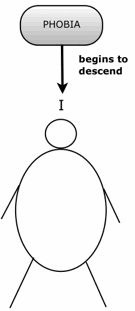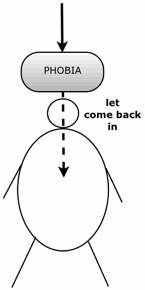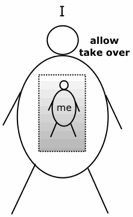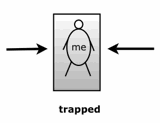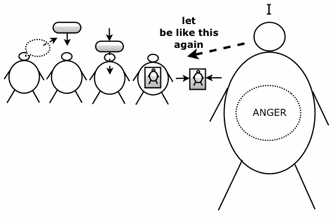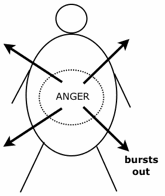Presented at The Developing Group, 6 June 2009
Let’s go back to basics — “from whence we came” as David Grove might have said — into the realm of embodied cchema – the basis of embodied cognition. Mark Johnson sums up the ‘experiential’ worldview in The Body in the Mind:
In order for us to have meaningful, connected experiences that we can comprehend and reason about, there must be pattern and order to our actions, perceptions, and conceptions. A schema is a recurrent pattern, shape, and regularity in, or of, these ongoing ordering activities. These patterns emerge as meaningful structures for us chiefly at the level of our bodily movement through space, our manipulation of objects, and our perceptual interactions. It is important to recognise the dynamic character of image [embodied] schemata as structures for organizing our experience and comprehension.
A schema consists of a small number of parts and relations, by virtue of which it can structure indefinitely many perceptions, images, and events. Image schemata operate at a level of mental organization that falls between abstract propositional structures, on the one side, and particular concrete images on the other. [Page 29]
Those who can cleanly model the words and nonverbals that represent how a person internally does what they describe, need to model at all three of Johnson’s organisational levels: specific example, embodied schema, and abstract conceptual.
Since the middle level — embodied schema — is the one most often neglected, this paper is devoted to extending your modelling skills in this area.
While the term “image schema” is often used in the quotations below, we prefer to use “embodied schema”. We feel this term more accurately reflects the multi-sensory experiential patterns acquired pre-verbally as children which are later revealed in the presuppositional nature of our verbal and nonverbal language.
Our, and other’s, embodied schemas are so common and embedded in thought and word that we seldom notice them — like a fish trying to notice water. Modelling embodied schema will enable you to develop something like ‘second sight’ into the organisation of others’ psychescapes. And as a result use Clean Language in subtly different and more precise ways.
Contents
- Image schemas
- Indicators of embodied schema
- Exercises
- Sample schema
- Indicators of embodied schema in the transcript
- Drawings of schema in the transcript
To introduce the basic premises of embodied schema we have extracted the following from Vyvyan Evans and Melanie Green, Cognitive Linguistics: An Introduction, Edinburgh University Press, 2006, pp. 177-191.
[NOTE: we have modified the diagrams and add comments in square brackets.]
1. Image Schemas
The theory of image schemas, which was first developed within cognitive semantics and has come to be highly influential in neighbouring areas of study such as cognitive and developmental psychology. The notion of an image schema is closely associated with the development of the embodied cognition thesis, proposed by early researchers in cognitive semantics, notably George Lakoff and Mark Johnson. One of the central questions raised by Lakoff and Johnson in their (1980) book Metaphors We Live By can be stated as follows: Where does the complexity associated with our conceptual representation come from? The answer they offered was that this complexity is, in large measure, due to a tight correlation between the kinds of concepts human beings are capable of forming and the nature of the physical bodies we have. From this perspective, our embodiment is directly responsible for structuring concepts. In this section, therefore, we address the idea central to the thesis of embodied cognition: the image schema.
What is an image schema?
In his (1987) book The Body in the Mind, Mark Johnson proposed that embodied experience gives rise to image schemas within the conceptual system. Image schemas derive from sensory and perceptual experience as we interact with and move about in the world. For example, given that humans walk upright and because we have a head at the top of our bodies and feet at the bottom, and given the presence of gravity which attracts unsupported objects, the vertical axis of the human body is functionally asymmetrical. This means that the vertical axis is characterised by an up-down or top-bottom asymmetry: the top and bottom parts of our bodies are different.
Cognitive semanticists argue that given the asymmetry of the human vertical axis we have to stoop to pick up fallen objects and look in one direction (downwards) for fallen objects and in another (upwards) for rising objects. In other words, our physiology ensures that our vertical axis, which interacts with gravity, gives rise to meaning as a result of how we interact with our environment. According to Johnson, this aspect of our experience gives rise to an image schema: the UP-DOWN schema. [See example from a client session in Section 2]
Moreover, as shown by the developmental psychologist Jean Mandler, image schemas are emergent. This means that because this experience is a function of our bodies and of our interaction in the world, this type of experience arises in conjunction with our physical and psychological development during early childhood. In other words, image schemas are not claimed to be innate knowledge structures.
Although the term ‘image’ is restricted to visual perception in everyday language, it has a broader application in psychology and in cognitive linguistics, where it encompasses all types of sensory-perceptual experience. [Which is why we prefer to call them ‘embodied schema’]
The term ‘schema’ in ‘image schema’ is also very important: it means that image schemas are not rich or detailed concepts, but rather abstract concepts consisting of patterns emerging from repeated instances of embodied experience. If we take a parallel example from language, words like thing or container have rather more schematic meanings than words like pencil or teacup.
By way of illustration the image schema CONTAINER results from our recurrent and ubiquitous experiences with containers as revealed by this extract from Johnson’s (1987) book, which describes the start of an ordinary day:
You wake out of a deep sleep and peer out from beneath the covers into your room. You gradually emerge out of your stupor, and pull yourself out from under the covers, climb into your robe, stretch out your limbs, and walk in a daze out of the bedroom and into the bathroom. You look in the mirror and see your face staring out at your. Your reach into the medicine cabinet, take out the toothpaste, squeeze out some toothpaste, put the toothbrush into your mouth, brush your teeth in a hurry, and rinse out your mouth. (Johnson 1987: 331; our italics differ from the original)
As this example reveals by the recurrent use of the expressions in and out, a great number of everyday objects and experiences are categorised as specific instances of the schematic concept CONTAINER: not only obvious containers like bathroom cabinets and toothpaste tubes or less obvious ‘containers’ like bed-covers, clothing and rooms, but also states like sleep, stupor and daze.
Properties of image schemas
Image schemas are preconceptual in origin. However once the recurrent patterns of sensory information have been extracted and stored as an image schema, sensory experience gives rise to a conceptual representation. This means that image schemas are concepts, but of a special kind: they are the foundations of the conceptual system, because they are the first concepts to emerge in the human mind, and precisely because they relate to sensory-perceptual experience, they are particularly schematic. Sometimes it is more difficult to grasp the idea of an image-schematic concept than it is to grasp the idea of a very specific concept like CAT or BOOK. This is because these specific concepts relate to ideas that we are aware of ‘knowing about’. In contrast, image schemas are so fundamental to our way of thinking that we are not consciously aware of them: we take our awareness of what it means to be a physical being in a physical world very much for granted because we acquire this knowledge so early in life, certainly before the emergence of language.
An image schema can give rise to more specific concepts
Cognitive linguists often attempt to support their formal representations of meaning elements by using diagrams. The CONTAINER image schema consists of the structural elements interior, boundary and exterior: these are the minimum requirements for a CONTAINER (Lakoff 1987).
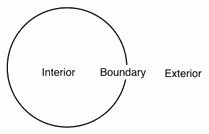
Figure 1: CONTAINER embodied schema
The reason why this diagram does not resemble any specific type of container (like a teacup, a house or a bad mood) is precisely because of its schematic meaning. The idea behind this type of diagram is that it ‘boils down’ the image-schematic meaning to its bare essence, representing only those properties that are shared by all instances of the conceptual category CONTAINER.
Let’s consider just two variants of the CONTAINER schema lexicalised by ‘out’:
Figure 2:
John went out of the room. Pump out the air. Let your anger out. Pick out the best theory. Drown out the music. Harry weaselled out of the contract. | 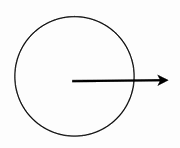 |
Figure 3:
The honey spread out. Pour out the beans. Roll out the red carpet. Send out the troops. Hand out the information. Write out your ideas. | 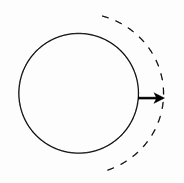 |
The image schemas in Figures 2 and 3 are more specific and detailed than the image schema diagrammed in Figure 1 because they involve motion as well as containment. This shows that image schemas can possess varying degrees of schematicity, where more specific image schemas arise from more fundamental schematic ones.
Image schemas are not the same as mental images
Mental images are detailed and result from an effortful and partly conscious cognitive process that involves recalling visual memory. This means that you can’t close your eyes and ‘think up’ an image schema in the same way that you can ‘think up’ the sight of someone’s face or the feeling of a particular object in your hand.
Image schemas are multi-modal
One of the reasons why we are not able to close our eyes and ‘think up’ an image schema is because image schemas derive from experiences across different modalities (different types of sensory experience) and hence are not specific to a particular sense. In other words, image schemas are buried ‘deeper’ within the cognitive system, being abstract patterns arising from a vast range of perceptual experiences and as such are not [normally] available to conscious introspection.
Image schemas are analogue representations
Image schemas are analogue representations deriving from experience. In this context, the term ‘analogue’ means image schemas take a form in the conceptual system that mirrors the sensory experience being represented. In other words, although we can try to describe image schemas using words and pictures, they are not represented in the mind in these kinds of symbolic forms. Instead, image-schematic concepts are represented in the mind in terms of holistic sensory experiences, rather like the memory of a physical experience.
Because image schemas derive from sensory experience, they are represented as summaries of perceptual states which are recorded in memory. However, what makes them conceptual rather than purely perceptual in nature is that they give rise to concepts that are consciously accessible (Mandler 2004). In other words, image schemas structure (more complex) lexical concepts.
Image schemas can be internally complex
Image schemas are often, perhaps typically, comprised of more complex aspects than can be analysed separately. An example of a complex image schema is the SOURCE-PATH-GOAL, or simply PATH schema. Because a path is a means of moving from one location to another, it consists of a starting point or SOURCE, a destination or GOAL, and a series of contiguous locations in between which relate the source and goal. Like all complex image schemas, the PATH schema constitutes an experiential Gestalt: it has internal structure but emerges as a coherent whole.

Figure 4: The PATH embodied schema
One consequence of internal complexity is that different components of the PATH schema can be referred to. This is illustrated below, where the relevant linguistic units are bracketed:
SOURCE
John left (England).
GOAL
John travelled (to France).
SOURCE-GOAL
John travelled (from England) (to France).
PATH-GOAL
John travelled (though the Chunnel) (to France).
SOURCE-PATH-GOAL
John travelled (from England) (through the Chunnel) (to France).
Image schemas can occur in clusters
Image schemas can occur in clusters or networks of related image schemas. To illustrate this, consider the FORCE schema, which actually consists of a series of related schemas. Force schemas share a number of properties:
Force schemas are always experienced through interaction
Force schemas involve a force vector, i.e. a directionality
Force schemas typically involve a single path of motion
Force schemas have sources for the force and targets that are acted upon
Forces involve degrees of intensity
Forces involve a chain of causality, a consequence of having a source, target, force vector and path of motion, e.g. a child throwing a ball at a coconut.
Johnson suggests that certain FORCE schemas underlie the basic or root meanings of [modal auxiliary] verbs (e.g. must, may, can): these meanings relate to socio-physical experience, as illustrated in the following sentences:
| a. You must move your foot or the car will crush it. | Physical necessity |
| b. You may now kiss the bride. | No parental, social or institutional barrier now prevents the bride from being kissed by the groom |
| c. John can throw a javelin over 20 meters. | He is physically capable of doing this |
Johnson argues that the root meaning of must (physical necessity) derives from the COMPULSION schema, while the root meaning of may (permission) to relate to the REMOVAL OF RESTRAINT schema and the root meaning of can (physical capacity) derives from the ENABLEMENT schema. Thus his claim is that the meanings associated with the modal verbs have an image-schematic basis which arises from embodied experience.
A partial list of embodied schemas
While far from exhaustive, the following list provides an idea of the range of image schemas that have been proposed so far in the literature. We group the image schemas according to the nature of their experiential grounding:
| SPACE: | UP-DOWN, FRONT-BACK, LEFT-RIGHT, NEAR-FAR [PROXIMITY], CENTER-PERIPHERY, CONTACT, STRAIGHT, VERTICALITY |
| CONTAINMENT: | CONTAINER, IN-OUT, SURFACE, FULL-EMPTY, CONTENT |
| LOCOMOTION: | MOMENTUM, SOURCE-PATH-GOAL |
| BALANCE: | AXIS BALANCE, TWIN-PAN BALANCE, POINT BALANCE, EQUILIBRIUM |
| FORCE: | COMPULSION, BLOCKAGE, COUNTERFORCE, DIVERSION, REMOVAL OF RESTRAINT, ENABLEMENT, ATTRACTION, RESISTANCE |
| UNITY- MULTIPLICITY: | MERGING, COLLECTION, SPLITTING, ITERATION, PART-WHOLE, COUNT-MASS, LINK(AGE) |
| IDENTITY: | MATCHING [-MISMATCHING], SUPERIMPOSITION |
| EXISTENCE: | REMOVAL [-REPLACE], BOUNDED SPACE, CYCLE, OBJECT, PROCESS |
| [SCALE:] | [MORE-LESS] |
| [SEQUENCE:] | [BEFORE-DURING-AFTER] |
[NOTE: words in square brackets are our additions]
Image schemas and metaphor
Let’s consider one more example. Consider the image schema OBJECT. This image schema is based on our everyday interaction with concrete objects like desks, chairs, tables, cars and so on. The image schema is a schematic representation emerging from embodied experience, which generalises over what is common to object: for example, that they have physical attributes such as colour, weight and shape, that they occupy a particular bounded region of pace, and so forth. This image schema can be ‘mapped onto’ an abstract entity like ‘inflation’, which lacks these physical properties. The consequence of this metaphoric mapping is that we now understand an abstract entity like ‘inflation’ in terms of a physical object. This is illustrated by the following examples:
a. If there’s much more inflation we’ll never survive.
b. Inflation is giving the government a headache.
c. Inflation makes me sick.
d. Lowering interest rates may help to reduce the effects of inflation.
Notice that it is only by understanding ‘inflation’ in terms of something with physical attributes that we can quantify it and talk about its effects. Thus image schemas which relate to and derive ultimately from pre-conceptual embodied experience can serve to structure more abstract entities such as inflation.
Conclusion
One of the most striking claims made by cognitive semanticists is that abstract thought has a bodily basis. In their influential research on conceptual metaphors, George Lakoff and Mark Johnson (1980) have argued that conceptual structure is in part organised in terms of a metaphor system, which is characterised by related sets of conventional associations or mappings between concrete and abstract domains. A domain in Conceptual Metaphor Theory is a body of knowledge that organises related concepts. The importance of image schemas is that they can provide the concrete basis for these metaphoric mappings.
Following are a number of practical examples and exercises which show how to make use of embodied schemas. They include:
- Extracts from a therapeutic client session and a list of verbs that indicate the FORCE embodied schema is in use
- A number of exercises for you to heighten your recognition and modelling skills
- Some of our ‘answers’ to the exercises including a detailed model of a piece of client transcript.
Further Reading
Evans, Vyvyan and Melanie Green, Cognitive Linguistics: An Introduction, 2006.
Johnson, Mark, The Body in the Mind, 1987.
Lakoff, George and Mark Johnson, Metaphors We Live By, 1980.
Lakoff, George and Mark Johnson, Philosophy in the Flesh, 1999.
Lakoff, George, Women, Fire and Dangerous Things, 1987.
Lindstromberg, Seth, English Prepositions Explained, 1998.
Tompkins, Penny and James Lawley (all available at cleanlanguage.com:
Symbolic Modelling and the Emergence of Background Knowledge, Rapport 39, Spring 1998.
A Model of Musing: The message in a metaphor, Anchor Point 16(5), May 2002.
Big Fish in a small Pond, NLP News, No. 7, Mar 2004.
Body Awareness, Developing Group, Sep 2004 (especially section 6).
Proximity and Meaning, The Model, Dec 2006.
2. Indicators of embodied schema
UP/DOWN Motif
The following sentences have been extracted from a one-hour client session. They illustrate the client’s repeated use of an embodied schema. Because of the repeating pattern we would characterise this client’s Landscape as having an up/down motif:
That’s me standing on top of a wave [about their desired state symbolic drawing]
I am able to achieve and fly high from a place of being more in touch with myself.
There’s a frequent sense of overwhelm.
I feel on top of things.
I want to take on the day without the day taking over me.
A lot of upheaval in the last year.
I want to be on top of my day.
I am building on …
I want to raise others’ awareness.
I’m up for it.
Checking up on it.
I need to be free of the heap.
[After a change had taken place in the client’s Landscape — a “missing” symbol comes inside]:
It’s like a pebble in the water dropping down in the whole of my core.
Now I’m sitting under a tree.
Dappled light drops down.
I feel calm and grounded.
Now I want to lie down under the tree and look up through the branches to the sky.
I feel settled in my gut, down here (hand on stomach).
It feels heavy in a positive settled way.
When I am in touch with the settled, grounded feeling it feels the natural thing to do.
Examples of verbs that indicate a FORCE embodied schema
| Active | Approach | Attack | Attract | Bear | Bond | Break |
| Build | Bring | Can’t | Capture | Carry | Cause | Clamp |
| Close | Clutch | Collect | Compel | Control | Cut | Deliver |
| Detain | Dive | Do | Drag | Endanger | Enlarge | Fall |
| Find | Fetch | Get | Go | Grab | Grapple | Grasp |
| Hold | Hug | Hunt | Immerse | Imprison | Influence | Interact |
| Jam | Join | Liberate | Limit | Make | Meet | Move |
| Obtain | Open | Operate | Overcome | Perpetrate | Penetrate | Pick |
| Power | Press | Provide | Pull | Push | Raid | Reach |
| Refrain | Resist | Restrict | Retain | Seize | Shake | Snatch |
| Start | Squeeze | Stay | Stick | Stop | Take | Tense |
| Try | Tug | Wake | Withhold | Wound | Wrench | Wrestle |
3. Exercises
Exercises 1 and 2 are taken from Vyvyan Evans and Melanie Green, Cognitive Linguistics: An Introduction, Edinburgh University Press, 2006, pp. 203 & 359-360.
Our modelling of *Exercises 3h, 4a and 4b can be seen below.
Exercise 1
Consider the following sentences and identify the embodied schemas that serve as the source for these metaphors:
(a) We need to weigh the arguments.
(b) They’re in trouble.
(c) The logic of her argument compelled me to change my mind.
(d) Interest rates have gone up again.
(e) It will prove to be heavy burden for the nation.
Exercise 2
Consider the following sentences featuring the English preposition ‘through’ and draw a schematic of the spatio-geometric properties of through for each of the above and identify which ones have the same embodied schema.:
(a) The relationship is through.
(b) The tunnel through Vale Mountain was completed in the 1980s.
(c) She did it through love.
(d)The trip abroad was funded through the miscellaneous fund.
(e) The ball whizzed through the hole in the net.
(f) He looked through the window.
(g) The relationship seemed to have evolved through the years.
(h) The dog jumped through the hoop.
(i) The skewer is through the meat.
(j) The stream runs through the pasture.
(k) The jogger ran through the tunnel.
Exercise 3
Draw a schematic of your model of the following client words:
(a) I’m driven to succeed.
(b) I can’t overcome the barrier.
(c) The faster I go the behinder I get.
(d) I was knocked off course at a very early age.
(e) The door of opportunity opened.
(f) Pure determination enabled me to get on in life.
(g) Her beauty drew me in against my will.
(h) I would like to make more progress towards writing a book that I have in mind.*
Exercise 4a
Identify the likely embodied schema inherent in the following client transcript:*
| FACILITATOR: | What has happened since last time? |
| CLIENT: | I felt more hopeful that the phobia will change but it just stays the same. I feel despairing about it. I desperately want it to be different but the phobia doesn’t change. It doesn’t budge. Living with it is exhausting, restrictive. It’s difficult as I haven’t had any respite. It seems to get worse. |
| FACILITATOR: | And is there anything else? |
| CLIENT: | I’m ok then I let my mind go. I don’t stop it. I can’t stop it. The phobia begins to descend and I let it come back in. I allow it to take me over. It makes me feel trapped. I feel angry that I let it be like this again. Then the anger just bursts out. |
| FACILITATOR: | And what would you like to have happen now? |
What do you conclude is the key motif (i.e. the pattern of embodied schemas)?
Exercise 4b
Use the embodied schemas identified in Exercise 4a to draw schematics (a model) of the forces and sequence of events described by the client.*
Our modelling of *Exercises 3h, 4a and 4b
4. Sample schema for Exercise 3(h)
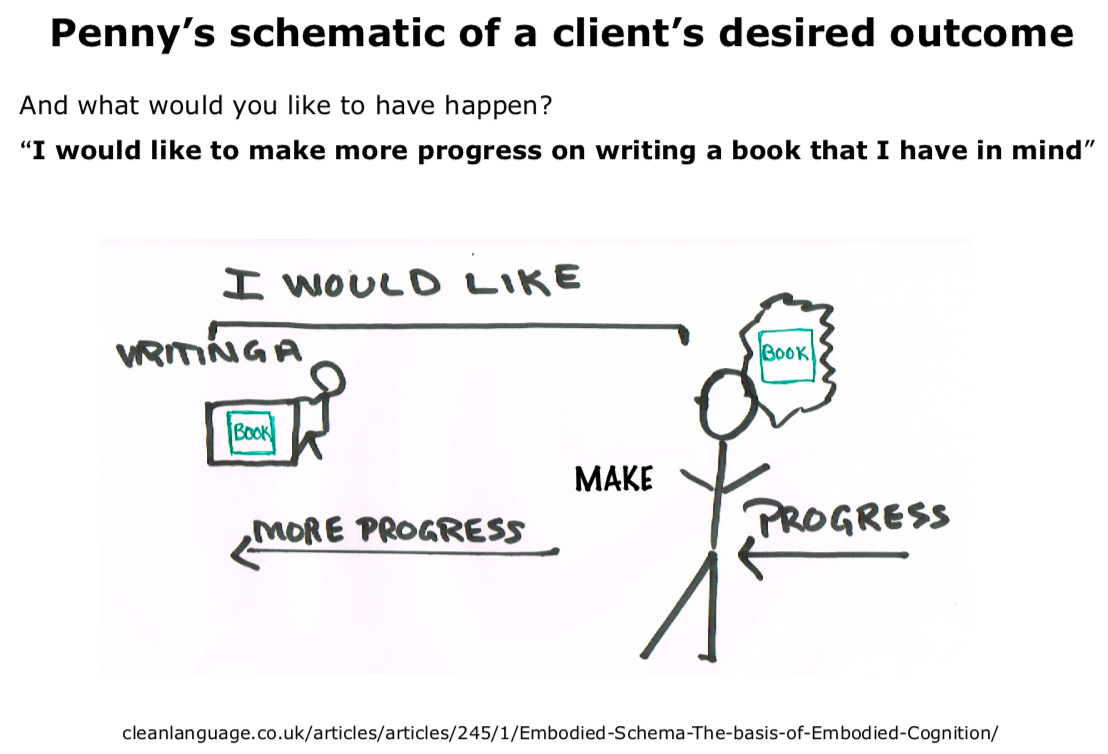
5. Indicators of embodied schema in the transcript (Exercise 4a)
In the following table we highlight (with different colours) the likely embodied schema inherent in the transcript given in Exercise 4a above.
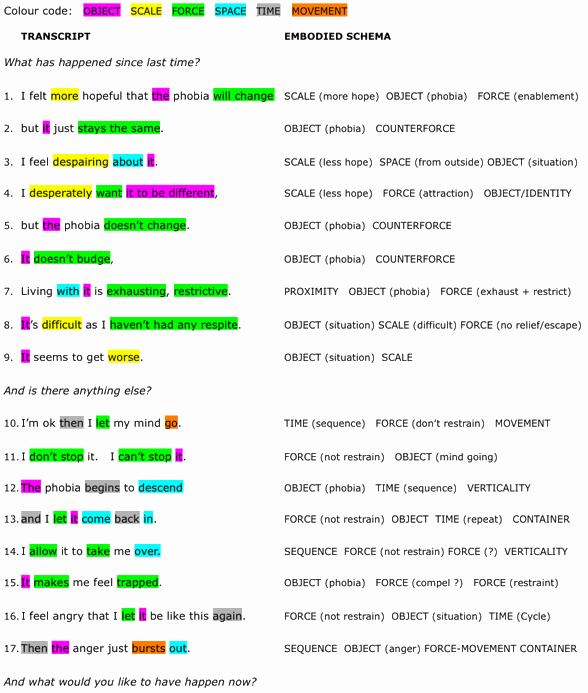
We characterise the primary motif of this client’s Metaphor Landscape as a pattern of COUNTERFORCE/NOT RESTRAIN embodied schema.
6. Drawings of embodied schema in the transcript (Exercise 4b)
The following are our models of the embodied schema inferred in the transcript in Exercise 4a. The section numbers refer to the way we divided up the transcript in our answer to Exercise 4a given above. [NOTE: There lots of other ways to represent the embodied schema].
Sections 1 – 9
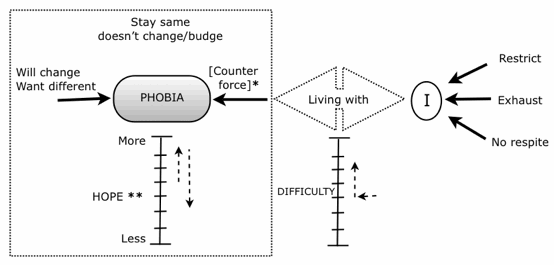
NOTES:
‘Counterforce’ is inferred – we do not have client’s words for what is keeping the phobia from changing.
‘Despair’ and ‘Desperate’ both mean ‘loss of hope’.
Section 10
| Sections 10-11
| Section 12
|
Section 13
| Section 14
| Section 15
|
Section 16
| Section 17
| |
NOTE: The sequence is not complete because the client must have some way of becoming “OK” again — in order for the whole cycle to repeat.


